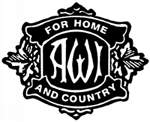Mary MacIsaac and Bess McDermand: Squaring Off With the Department of Agriculture
From its inception, the relationship between the AWI and the provincial government had potential for conflict. On the one hand, the goals of rural women and the Dept. of Agriculture seemed to coalesce in a mutual desire to improve the quality of life for rural families. On the other, the means by which they wished to achieve these goals and the timeframe within which they wished to work did not always match up. The AWI was formed during a time of great social change. And, although it was intended to be non-partisan and non-sectarian, it was politically active through its annual conventions and other avenues in promoting a progressive agenda for social change. One of the flash points was the position of Superintendent of the AWI.
Once the Alberta Department of Agriculture had decided to organize the Women’s Institutes, it looked for direction from the experience in Ontario, where the formal relationship between government and institutes had already been shaped. In searching for leaders to establish a similar relationship in Alberta, the department turned to graduates from the home economics and nursing programs of post-secondary institutions in Ontario to serve as the first superintendents of the AWI. These young women were in the vanguard of the “new women” in Canada: they were intelligent, they were well-educated, they were vocal, and they were in a hurry.
The first Superintendent of the AWI, Georgina Stiven, had graduated from the household science program at the Ontario Agricultural College. Stiven worked with Roberta MacAdams through 1912 and 1913 to establish WI branches along the railroad lines served by the Mixed Special Demonstration trains. At each place where the train stopped to provide demonstrations and lectures to rural men and women, MacAdams and Stiven helped local women to organize a WI branch. Stiven began to write a handbook for WI branches, but she left government service in 1914 to get married before the Handbook was published.
Mary MacIsaac, who served as Superintendent of the AWI from 1915-1921, replaced Stiven. MacIsaac had graduated as a nurse from the Toronto General Hospital; she brought fire and determination to the Institutes movement, not just in Alberta, but across the country. The list of Mary MacIsaac’s accomplishments is impressive. She established short courses in the areas of home nursing, child welfare and household science. She added two cars to the Mixed Farming Special Train just for the use of women: one of these was organized as a nursery so that women could concentrate on the lectures and demonstrations offered in the other car. She travelled the province with the equally enthusiastic and able president of AWI, Isobel Noble, organizing as many branches as possible. By 1918, their work was finding tangible results in 212 branches and approximately 8.000 members. In 1919 alone, MacIsaac had arranged for 139 short courses and 503 demonstration lectures, as well as distributing “30,000 bulletins on home Nursing, Sewing, Canning and Child Welfare and food cards for infants and small children….” (Wood, 11).
With the strong support of Mary MacIsaac, the AWI organization was now pressing the government for equal parental rights in questions of guardianship/ supervision of children in school playgrounds at noon and recess/ and free medical care for patients with tuberculosis. Each year brought a long list of resolutions from the WI convention, as well as numerous committee visits to the Minister.
Not content with guiding the Alberta organization, MacIsaac could see how a federation of Women’s Institutes across the country could enhance women’s success in garnering social change. She worked with Isobel Noble, Emily Murphy and others to create the Federate Women’s Institutes of Canada (FWIC) in 1919. Emily Murphy was its first president.
During MacIsaac’s tenure as Superintendent, the volume of work necessitated hiring an Assistant Superintendent. Bess McDermand, another graduate of both the OAC and the teacher’s college of Columbia University, assumed the task of organizing the Girls’ Clubs in 1919, becoming its first Supervisor. As capable and enthusiastic as Mary MacIsaac, Bess acted as Superintendent while MacIsaac was attending FWIC meetings, supervising at the Minister’s request the relief efforts for drought-stricken southern Alberta.
The Alberta Women’s Institutes was delighted with its accomplishments and especially with the partnership it had forged with these two young women. However, a change in government in 1921 resulted in the dismissal of MacIsaac and in 1922 on McDermand, who then left the province, taking her expertise with her to a position as Superintendent of the Ontario WIs. The organization was never again able to rely on the dedicated efforts of such highly trained specialists in domestic science.
Sources:
MacIsaac, Mary. Handbook for Women’s Institutes. Edmonton: Dept. of Agriculture, 1916.
Wood, Cornelia. The Story of the Alberta Women’s Institute, 1909-1955. n.p., 1955.
